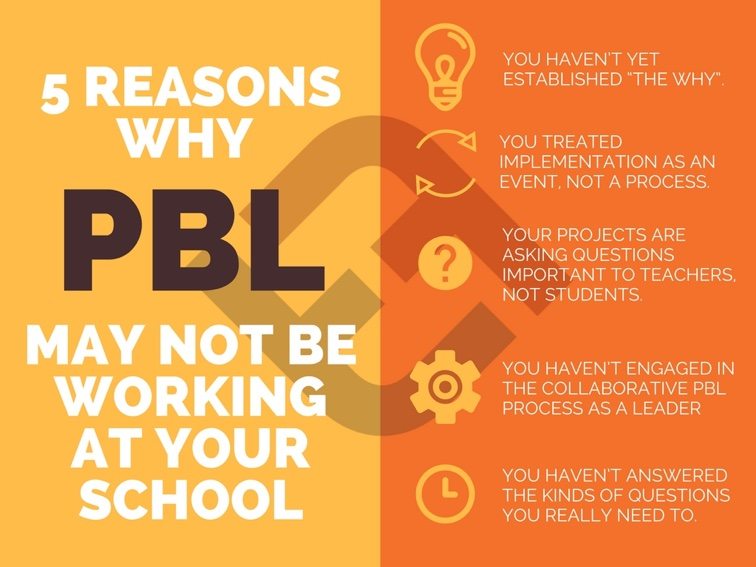
5 Reasons Why PBL May Not Be Working At Your School
contributed by Drew Perkins
Is the project-based learning happening but not working?
You’ve read the books, liked and retweeted the tweets, listened to the podcasts, and drank the Kool-Aid. Excitedly, you watched as teachers started their projects with their students, eagerly anticipating their exhibitions of learning as their projects concluded.
And then you were disappointed.
Why weren’t students more excited about their projects? Why didn’t teachers seem to be incorporating more of the PBL workshop principles in their teaching? Where was the deeper learning and student empowerment you expected?
Before you dump out that Kool-Aid and move on to the next promising idea (you don’t really do that, do you?), take a look at some of the reasons this first foray into PBL may not have gone as you’d hoped and see what we can do to grow from here.
You haven’t yet established “The Why’
To really get buy-in from teachers, they have to feel compelled to change, especially from those more seasoned ones. They’ve seen enough PD ideas come and go and maybe compliant enough to try something new, but you want commitment. If teachers aren’t energized enough to work on the finer points of design and implementation, they probably won’t be likely to push through the inevitable rough spots.
Engaging stakeholders in clarifying what it is they actually want their teaching to attain, holding that up against their current practice, and analyzing how PBL might bridge that gap can help establish ‘The Why.’ Without that step, teachers will likely feel like PD is being done ‘to them’ again.
You treated implementation as an event, not a process.
School leaders often have more on their plates than is reasonable. I fall into the trap of doing what needs to be done now and putting off what isn’t immediately pressing. Maybe that’s why you booked the initial workshop but didn’t plan for any follow-up and support.
Whatever the reason, it’s best to look at PBL implementation as a process with the initial workshop as only a starting point. In year one alone, there are stages of support to consider. How might you help teachers tune their projects before implementation? Will there be any observation with feedback while projects are underway? What about reflection and processing with a thought partner, coach, and peers to help ensure an understanding of quality for refinement?
For several reasons, it’s more likely than not that your first few projects will be fairly surface-level. Treating it as a 3-5 year process with supports and coaching gives teachers (and students) a chance to get better while not feeling like they have to be perfect right out of the gate. It also gives you the necessary time to create the culture and at least start making some of the changes in curriculum and systems that may be necessary to do true authentic and deeper learning.
Your projects are asking questions important to teachers, not to your students.
I’ve written about this before but it’s important enough to repeat. Many questions are worth considering, and many are content-specific, often called essential questions. However, it’s vital to remember that just because they’re interesting, worthwhile, rich, and even awesome to us as adults doesn’t mean our students care. Projects that pose authentic, meaningful, and relevant problems to students are what will draw students in.
That doesn’t mean we don’t still want them to think through those essential questions but our design challenge is to create a PBL Driving Question that pulls those essential questions out as true “Need to Knows”. Now you’re cooking because instead of teachers prescribing these questions as important, the students have identified them as such. Students are now much more likely to own it and connect it in ways that push the project toward deeper learning.
You haven’t engaged in the collaborative PBL process as a leader but expect your teachers to.
In a recent podcast with Peter DeWitt we hit upon the idea of collaborative leadership. In both I emphasized the value of leadership engaging in the PBL workshop and applying those principles with their staff. This is important for at least a few reasons.
First, it’s hard to imagine how you might effectively engage in instructional leadership on PBL without a deep understanding of it. Second, it’s a powerful way to empower your staff by providing opportunities for their voices to be heard on important matters. Some leaders may be hesitant to “relinquish” that power but trust me, it’s actually doing quite the opposite. Posing challenges, soliciting Need to Knows, and following the PBL process may not give you the answer(s) you were thinking of but it might provide better ones. You’ll want to ask the right questions of course but that’s true leadership. A third reason to engage in the PBL process as a leader is so your teachers see you a learner right beside them.
It’s well past time to move from the top-down, hierarchical leadership model. Besides, if you’ve identified PBL as something important enough to try to implement with students, isn’t it important enough to engage in as adults and professionals?
You haven’t answered the kinds of questions you really need to.
I’ve written about this before in 7 Questions To Guide Your PBL Implementation Plan and you can read the specifics there but if you jumped into your PBL implementation without considering the Why Questions, What Questions, ‘How’ Questions, ‘When’ Questions, Guiding Questions, Quality Questions, and Assurance Questions it’s not too late.
Sit down with your teachers and engage them in professional dialogue around these and more. It might even be smart to let them know you put the cart before the horse, we all make mistakes. Trying to plow forward without working through these will more likely stall much progress and leave teachers frustrated with professional development once again.
Clearly, there may be other reasons why PBL isn’t taking off quite like you’d hoped. Perhaps there’s too much focus on testing and accountability, maybe leadership is ineffective, or maybe you’ve started with a poor (or overly expensive) PD provider. Whatever the explanation do your due diligence before ditching it for the next shiny thing. Quality PBL teaching and learning doesn’t happen overnight and can certainly be a challenge to implement but it’s worth the payoff if we truly want to prepare our students for the modern world.
